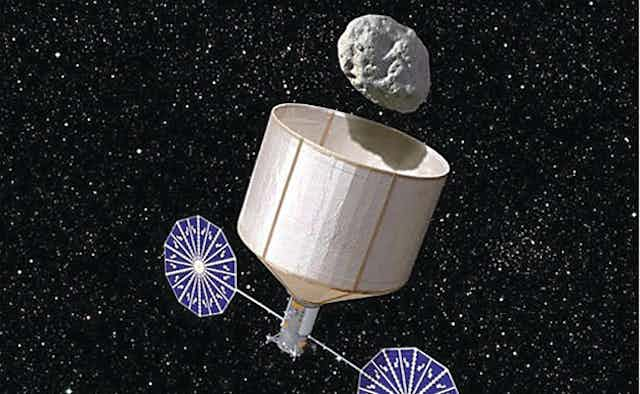Harvesting space resources will raise living standards worldwide, without further damaging Earth. So how can those resources be tapped in a way that will produce a return on investment?
That question may have been hypothetical in the past; now, it’s of pressing concern.
In February, the centre I work for at UNSW hosted a forum on an exotic topic: mining the resources on asteroids and the moon. It brought together space engineers, world-class Australian miners, and some Australian experts in fields such as robotics.
The event followed announcements of some start-ups in off-Earth mining, some of which had powerful backers. It seemed like a typical, low-key academic exercise.
To our surprise, the forum received international media attention. We were exhausted by a week’s worth of constant TV and radio interviews. No-one expected this, and we’re still struggling to understand it.
Interest may have been fuelled by some of the novel space accomplishments of the last year:
a commercial company, SpaceX, has built an unmanned spacecraft that has twice rendezvoused and attached to the International Space Station (ISS)
NASA is testing robots at the ISS for refuelling satellites on orbit
the Curiosity rover is drilling rocks on Mars: just as one might prospect for minerals on an asteroid

These high-profile missions are in the collective consciousness, and many people may know preliminary plans are underway for an asteroid-capture mission.
Such space feats also suggest that the technology is more in hand than one realised – more science-fact than science-fiction.
The challenge now is to establish viable businesses, and the economics must be clarified to bring investors to the table.
For what it’s worth
What are space resources even worth? Consider the asteroid, named 2012 DA14, that buzzed past the Earth in February. One valuation of its water and mineral contents was US$195 billion. Another was zero.
Well, that’s helpful.
Such ambiguity arises from the lack of market definition. One could bring resources back to Earth, where markets exist. There are valuable resources out there, such as the platinum and diamonds known to be on asteroids.
But terrestrial market prices probably do not support the costs of obtaining solar system minerals.
By contrast, resources obtained and used in space have an inherent value: the avoided cost of launching equivalent resources from Earth. Today that’s at least US$7 million a tonne to low Earth orbit, and perhaps three times that to higher orbits. That represents an attractive price for those resources.
But markets for in-space uses of space-obtained resources are currently hypothetical: filling fuel depots to make interplanetary travel more efficient; processing in-situ resources to support human settlements; building orbiting solar power stations to beam clean energy to Earth.

Resources that will be valuable in space will not be the ones that could be sold back on Earth. As a colleague said at our forum: “If you’re stranded in the desert, gold is useless and water is priceless.”
The two most valuable commodities could be construction materials (for the structure, say, of a huge space solar power station) and water (processed into rocket fuel, or used for human habitation).
Emerging markets
How will space resources markets emerge? Some people have suggested they will come to the fore via a disruptive innovation model, whereby a lower-quality, lower-cost product makes small inroads into an existing market, the profits fund product improvement and, eventually, the new product dominates.
But since there is no existing space market, this would seem unlikely.
Perhaps the commercial aviation industry provides a better model. This market, so critical to the global economy, has grown for decades at 4% even in the US, and 5% worldwide. As we all know, that industry began modestly.

Government investments, such as air-mail services and air traffic control systems, were critical to aviation’s early growth and ultimate profitability. New applications continuously expand the market – so we can thank commercial air-cargo services for fresh sushi.
The space resources market is likewise developing modestly. The first product the American “asteroid-mining” company Planetary Resources will launch consists of tiny, low-cost telescopes:

The telescopes’ primary function is to find asteroids suitable for mining, but they may also be used to image the Earth, generating near-term revenue while waiting for the resources market to develop.
The business plan of the privately-held American company Deep Space Industries envisions medium-term revenues from operators of commercial communications satellites, who will buy propellant to extend the satellites’ lifetimes.
We have reached the point where the question is no longer “is the commercialisation of space possible?” but rather: “what is the path to return on investment?”
Combined economic, environmental and social forces will propel the industry to a high level of importance in the coming decades.

